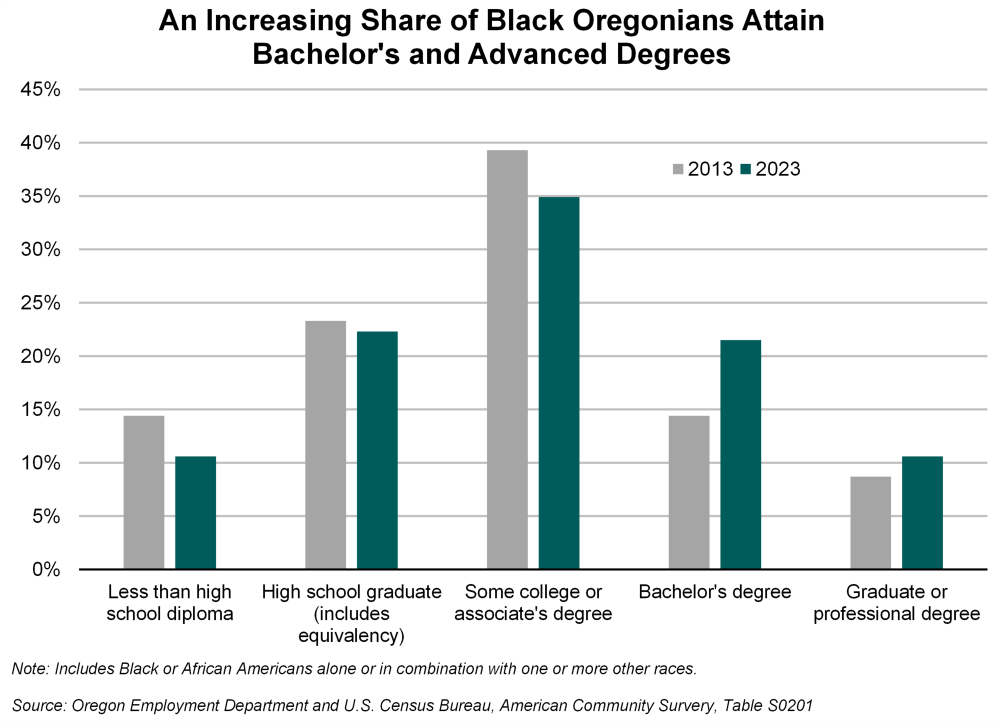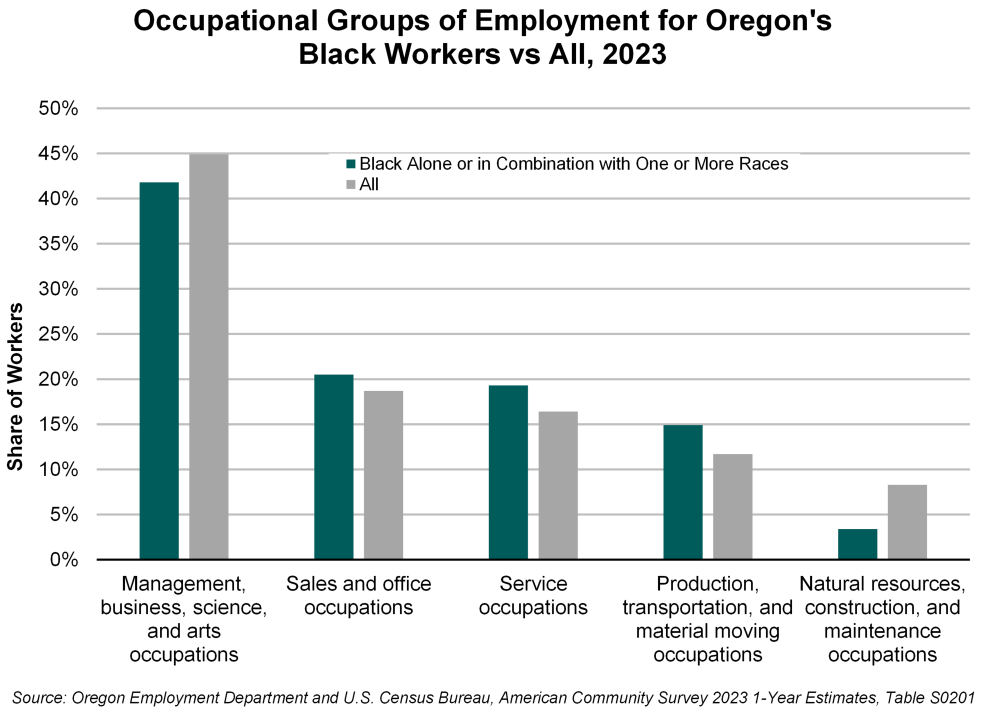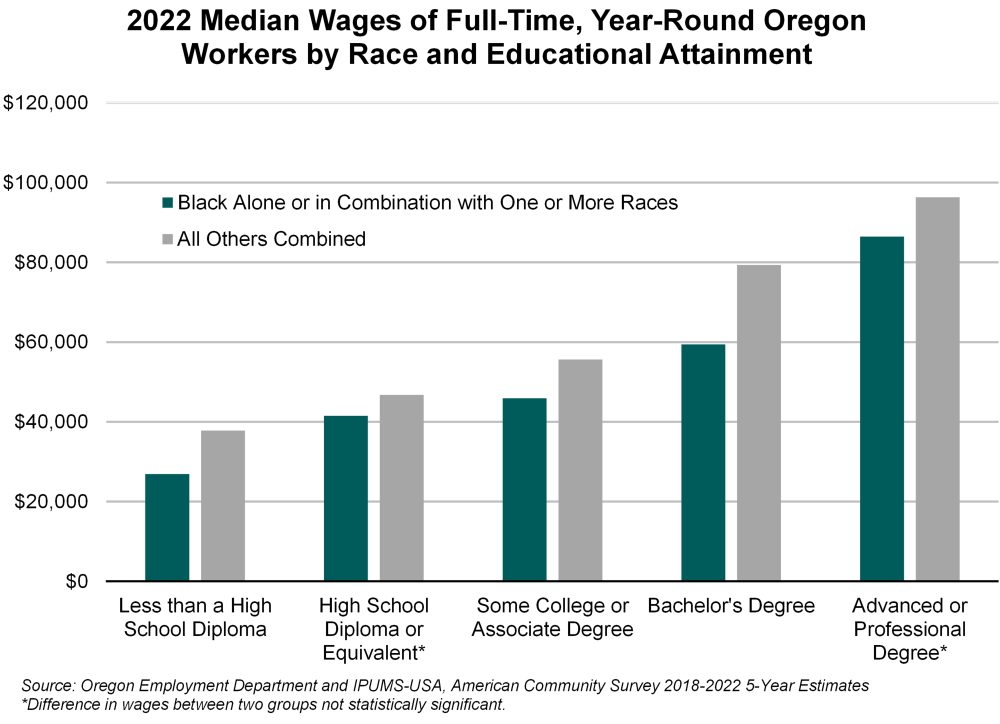African Americans in Oregon: A Labor Market Perspective
February 26, 2025According to 1940 United States Census Bureau records, Black or African Americans made up roughly 10% of the U.S. population in the years prior to World War II. During that same period in Oregon, the state’s 3,600 Black residents made up just 0.3% of the state’s population. The Census’ most recent estimates show that as of 2023, 14% of people in the U.S. identify as Black alone or Black in combination with one or more other races, yet just 3% of Oregon’s residents identify as Black. Why do so few Black people live in Oregon? According to the Oregon Encyclopedia, “Oregon's racial makeup has been shaped by three black exclusion laws that were in place during much of the region's early history. These laws, all later rescinded, largely succeeded in their aim of discouraging free blacks from settling in Oregon early on, ensuring that Oregon would develop as primarily white.” The small share of Black residents in Oregon in combination with the state’s relatively small population make comparing labor market outcomes for Black residents with the state’s overall population challenging. This article analyzes available data to capture the economic landscape of the Black population in Oregon, how it has changed over the past decade, and how it compares with the state as a whole.
Oregon’s Black Population is Diverse, Young, and Growing
The number of Black people living in Oregon has grown by 37% over the last decade to nearly 146,000 people, according to American Community Survey (ACS) 2023 estimates. Two out of five (40%) Black people in the state identify themselves as Black or African American in addition to one or more other races. Oregon’s Black population is relatively young, with a median age of 28.3 years in 2023 compared to 40.7 years across all races in Oregon.
Oregon’s Black residents are centered in the state’s urban core, with 44% living in Multnomah County compared with just 19% of all Oregon residents.
Educational Attainment on the Rise
While the share of people aged 25 and older with a bachelor’s degree or higher is slightly lower for Oregon’s Black residents (32%) compared with all in the state (38%), Black Oregonians have achieved increasing levels of educational attainment over the past decade. The share of Black people whose highest level of educational attainment is a bachelor’s degree increased by 7 percentage points to 22% from 2013 to 2023. The share with a graduate or professional degree increased by 2 percentage points to 11% during the same period. Increased levels of educational attainment typically improve employment outcomes in terms of lower unemployment rates and higher earnings, which we will explore in the following sections.

Employment
According to the U.S. Census Bureau, workers who identified as Black made up roughly 3% of the state’s workforce in 2023. The share of Black workers in Oregon has grown at more than four times the rate of the state’s overall workforce over the past decade (77% vs. 18%), increasing from 37,000 people in 2013 to 66,000 people in 2023.
In 2023, most Black workers in the state worked in management, business, science, and arts occupations (42% of workers); followed by sales and office occupations (21%); and service occupations (19%). Small survey sample sizes limit the ability to make meaningful comparisons in occupational employment for Oregon’s Black workforce compared to employment for all workers across the state in many cases except for natural resources, construction, and maintenance occupations in which Black workers are less than half as likely to be employed (3% vs 8%).

Nationally, Black workers are more likely to be employed in service (22% vs 16%) and production, transportation, and material moving occupations (18% vs 13%) than workers across all races. Black workers are less likely to be employed in management, business, science, and arts (36% vs 43%) in addition to natural resources, construction, and maintenance occupations (5% vs 8%).
Labor Market Outcomes
The Black population’s labor force participation rate has increased to become higher than for the state’s overall population, driven in part by increased levels of educational attainment in the Black community and overall improving labor market conditions. However, Black Oregonians continue to suffer from a significantly higher unemployment rate at 7.7% compared with 5.4% for all in Oregon’s labor force on average from 2019 to 2023.

Along with improving labor force participation rates, real average annual wages for Black workers in Oregon have increased by 28% over the decade to $59,100 in 2023. The rate of growth has been faster than the 20% wage growth that was experienced across all workers during this period. Nevertheless, average annual earnings for Black workers were 16% lower (or $11,100) than earnings for all workers.

Wage gaps between Black workers and all others in Oregon are persistent across most levels of educational attainment for full-time, year-round workers over the age of 25. The largest wage gap occurs at a higher end of the educational attainment spectrum, with Black workers in Oregon with a bachelor’s degree earning median wages roughly $19,900 less than their equally educated peers from 2018 to 2022. Black workers with some college or an associate degree statewide earned $9,700 less than all other workers. Wage differences in Oregon were not statistically significant at the high school diploma and advanced or professional degree levels.

Wages consistently increase along with educational attainment for both groups of workers statewide. Black workers in Oregon with some college or an associate degree, a bachelor’s degree, and an advanced or professional degree earned median wages of $46,000, $59,000, and $86,000 respectively from 2018 to 2022. Median annual wages were nearly $14,000 (29%) higher for Black workers with a bachelor’s degree compared to those with some college or an associate degree, and more than $27,000 higher (45%) for workers with an advanced or professional degree compared to those with a bachelor’s degree.
Factors like age, gender, and occupation are hard to control for in Oregon due to sample size limitations that affect data reliability, but national data show that none of these factors can completely explain why an earnings gap exists. The Federal Reserve Bank of Minneapolis explains in a study of their own labor market that, “Unequal labor market outcomes are not a consequence of the labor market alone but also reflect the institutionalization of systemic racism through less opportunity in education, housing, location, and the criminal justice system.” Research from the Federal Reserve Board shows that relative labor market outcomes for Black people improve under tight labor market conditions and worsen during recessions.
Keep Moving Forward
Though only a small share of the state’s population, Oregon’s Black population is diverse, young, and has grown quickly over the last 10 years. Black Oregonians have achieved higher levels of educational attainment over the past decade and have experienced better economic outcomes including higher labor force participation, lower unemployment rates, and higher earnings. However, disparities in labor market outcomes between Black people and all in Oregon persist.
Eradicating economic disparities between marginalized groups of people will increase the U.S.’s overall economic output and improve the lives of individuals and families. To keep moving forward towards better economic outcomes, a combination of individual and policy-level efforts are necessary. Individuals can increase their earnings and decrease their likelihood of becoming unemployed through education and training efforts. Key federal agencies such as the Federal Reserve Bank of America can act in ways that promote economic recovery and expansion for longer periods of time, and state and local government can ensure their policies are inclusive of everyone in their communities. Businesses also have a role to play by examining and improving their policies related to the hiring, retention, and promotion of workers.
Additional Information
For Oregon employers looking for ways to better support diversity in the workplace, Partners in Diversity offers a variety of resources tailored for employers and professionals of color in the Pacific Northwest.
For more information about Black workers and proposed solutions to improve their employment outcomes, see the Federal Reserve Bank of Minneapolis’ recap on its event Racism and the Economy: Focus on Employment.